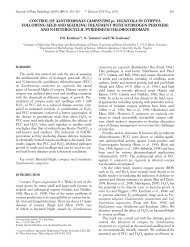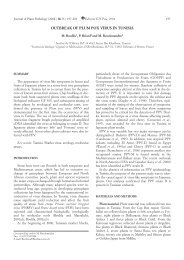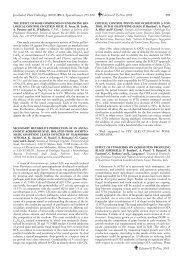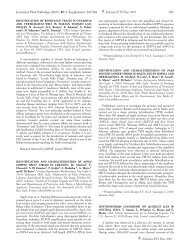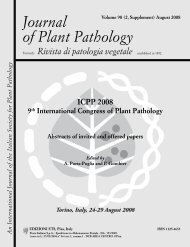Journal of Plant Pathology (2010), 92 (4, Supplement ... - Sipav.org
Journal of Plant Pathology (2010), 92 (4, Supplement ... - Sipav.org
Journal of Plant Pathology (2010), 92 (4, Supplement ... - Sipav.org
You also want an ePaper? Increase the reach of your titles
YUMPU automatically turns print PDFs into web optimized ePapers that Google loves.
S4.74 <strong>Journal</strong> <strong>of</strong> <strong>Plant</strong> <strong>Pathology</strong> (<strong>2010</strong>), <strong>92</strong> (4, <strong>Supplement</strong>), S4.71-S4.105<br />
mass spectrometry analyses showed that the MW <strong>of</strong> the protein<br />
was higher than that expected for CU. This protein was purified<br />
and characterized. Applying Edmann sequencing and Genome<br />
Walking techniques, we obtained a partial nucleotide sequence <strong>of</strong><br />
the gene and an amino acid sequence <strong>of</strong> the protein, that were<br />
different from those known for CU. Our results show that isolates<br />
<strong>of</strong> Geosmithia spp. harbour two different hydrophobin<br />
genes: one, homologous to the cu gene from O. novo-ulmi, could<br />
have been acquired by HGT between the two fungal species, as<br />
they occupy the same habitat in elm trees. The other gene codes<br />
for a new hydrophobin, named Geo1, with a good homology level<br />
to the O. novo-ulmi CU protein.<br />
ACTIVITY OF THE MICROBIAL CONTROL AGENT<br />
BACILLUS SUBTILIS STRAIN QST 713 AGAINST BACTE-<br />
RIAL CANKER OF KIWIFRUIT. E. Biondi 1 , S. Mucini 1 , C.<br />
Lucchese 1 , E. Ladurner 2 , M. Benuzzi 2 , P. Minardi 3 , U. Mazzucchi<br />
1 . 1 Dipartimento di Scienze e Tecnologie Agroambientali,<br />
Sezione di Patologia Vegetale, Università degli Studi, Viale Fanin<br />
40, 40127 Bologna, Italy. 2 Intrachem Bio Italia, Servizio Tecnico,<br />
Ricerca e Sviluppo, Via Calcinaro 2085, 47023 Cesena, Italy. 3 Dipartimento<br />
di Morf<strong>of</strong>isiologia Veterinaria e Produzioni Animali,<br />
Università degli Studi, Via Tolara di Sopra 50, 40064 Ozzano dell’Emilia<br />
(BO), Italy. E-mail: umberto.mazzucchi@unibo.it<br />
Bacterial canker <strong>of</strong> kiwifruit, caused by Pseudomonas syringae<br />
pv. actinidiae (Psa), became relevant, especially in 2008 and 2009.<br />
Epidemics occurred in Lazio and Emilia Romagna (central and<br />
northern Italy) and the causal <strong>org</strong>anisms were identified on the<br />
basis <strong>of</strong> phenotypic and genomic characteristics. In Italy, the control<br />
<strong>of</strong> bacterial canker relies mainly on agronomic prophylactic<br />
measures and on the use <strong>of</strong> copper-based products. In this study,<br />
we investigated the ability <strong>of</strong> Bacillus subtilis strain QST-713 (Serenade<br />
Max) to inhibit the growth <strong>of</strong> two different Psa strains in<br />
vitro, and its ability to survive and reduce the population <strong>of</strong> two<br />
rifampicin resistant pathogen strains on female flowers <strong>of</strong> Actinidia<br />
chinensis and A. deliciosa. The microbial control agent was<br />
able to survive on female flowers <strong>of</strong> both Actinidia species, reaching<br />
a population <strong>of</strong> ca. 10 5 CFU/flower 48 and 96 h after application.<br />
Moreover, the antagonist reduced the Psa population on A.<br />
chinensis flowers by more than one order <strong>of</strong> magnitude 48 h after<br />
its application. These preliminary results indicate that B. subtilis<br />
strain QST 713 may be a promising tool for the biological control<br />
<strong>of</strong> bacterial canker <strong>of</strong> kiwifruit, and provide insights into the interaction<br />
between the microbial control agent and Psa.<br />
ANTIFUNGAL ACTIVITY OF THREE NOVEL SAPONINS<br />
FROM ALLIUM CEPA. G. Bonanomi 1 , A. Gargiulo 1 , V. Antignani<br />
1 , V. Lanzotti 2 , F. Scala 1 . 1 Dipartimento di Arboricoltura,<br />
Botanica e Patologia Vegetale, Università degli Studi di<br />
Napoli“Federico II”, Via Università 100, 80055 Portici (NA), Italy.<br />
2 Dipartimento di Scienze degli Alimenti, Università degli Studi di<br />
Napoli “Federico II”, Via Università 100, 80055 Portici (NA), Italy.<br />
E-mail: giuliano.bonanomi@unina.it<br />
During their life cycle plants interact with a wide range <strong>of</strong> different<br />
microbial species, including pathogens. Thousands <strong>of</strong> diverse<br />
natural products are produced by plants and many <strong>of</strong> these<br />
are involved in plant defence. The phytochemical diversity <strong>of</strong> antimicrobial<br />
compounds include terpenoids, phenolics, phenylpropanoids,<br />
stilbens, alkaloids, glucosinolates, indole and<br />
saponins. In this study, the effects <strong>of</strong> three novel saponins<br />
(ACE15G3, ACE15E, ACE15D4) isolated from Allium cepa were<br />
tested on soil-borne pathogens (Fusarium oxysporum f. sp. lycopersici,<br />
Rhizoctonia solani and Sclerotium cepivorum), air-borne<br />
pathogens (Alternaria alternata, Aspergillus niger, Botrytis cinerea,<br />
Mucor sp., Phomopsis sp.) and two antagonistic fungi (Trichoderma<br />
atroviride and T. harzianum). Antifungal activity <strong>of</strong> all three<br />
saponins increases with their concentration and varied with the<br />
following rank: ACE15G3 > ACE15E ~ ACE15D4. F. oxysporum<br />
f. sp. lycopersici, S. cepivorum and R. solani were very little affected<br />
by saponins. Among the other fungi, B. cinerea and the two<br />
Trichoderma species were the most sensitive. We found a significant<br />
synergism in the antifungal activity <strong>of</strong> the three saponins<br />
against B. cinerea. Growth <strong>of</strong> this fungus was strongly inhibited<br />
when the three saponins were applied in combination.<br />
PLANT LITTER PHYTOTOXICITY AND SOIL-BORNE<br />
PATHOGENS CAN EXPLAIN TREE DIVERSITY GRADI-<br />
ENT AT GLOBAL SCALE. G. Bonanomi 1 , F. Giannino 2 , G.<br />
Incerti 4 , S. C. Dekker 3 , M. Rietkerk 3 , S. Mazzoleni 1 . 1 Dipartimento<br />
di Arboricoltura, Botanica e Patologia Vegetale, Università<br />
degli Studi di Napoli “Federico II”, Via Università 100, 80055 Portici<br />
(NA), Italy. 2 Dipartimento di Ingegneria Agraria e Agronomia<br />
del Territorio, Università degli Studi di Napoli “Federico II”, Via<br />
Università 100, 80055 Portici (NA), Italy. 3 Department <strong>of</strong> Environmental<br />
Sciences, Copernicus Institute, Utrecht University, PO Box<br />
80115, 3508 TC Utrecht, The Netherlands. 4 Dipartimento di Scienze<br />
della Vita, Università degli Studi, Via Gi<strong>org</strong>ieri 10, 34127 Trieste,<br />
Italy. E-mail: giuliano.bonanomi@unina.it<br />
The diversity <strong>of</strong> plant species increases from the poles to the<br />
equator ranging from almost monospecific forests at high latitude,<br />
to intermediate species richness in temperate climates, to<br />
the hyper-diverse tropical forests. For plants in aquatic ecosystems,<br />
however, this does not occur. Current theories based on resources<br />
competition cannot explain such latitudinal patterns <strong>of</strong><br />
plant diversity. Moreover, the co-occurrence <strong>of</strong> hyper-diverse<br />
stands in lowland terra firma forests and almost monospecific<br />
stands in mangroves and gallery riparian vegetation within the<br />
tropics remains enigmatic. Here we present a new mathematical<br />
model in which, besides the positive feedback <strong>of</strong> plant growth by<br />
nutrients release, litter decomposition and associated changes in<br />
soil microbial communities build up a species-specific negative<br />
feedback due to soil-borne pathogens and phytotoxicity released<br />
by the decaying plant litter. We validated the model by comparing<br />
it with extensive published data sets collected both across and<br />
within latitudinal or climatic zones. The model predicts correctly<br />
the number <strong>of</strong> tree species, their relative abundance as well as<br />
their biomass production in all environmental conditions providing<br />
a putative explanation also for the diversity variations observed<br />
within the tropics. The model advances in the direction <strong>of</strong><br />
a unifying ecosystem theory and demonstrates a mechanistic link<br />
between the carbon cycle, the soil microbial communities and the<br />
tree diversity patterns.<br />
DISCOVERY OF NEW PHLOMIS SPECIES NATURALLY<br />
INFECTED WITH PHLOMIS MOTTLE VIRUS. D. Boscia 1 ,<br />
P. Saldarelli 1 , A. De Stradis 1 , C. Vovlas 2 . 1 Istituto di Virologia<br />
Vegetale del CNR, UO Bari, Via Amendola 165/A, 70126 Bari,<br />
Italy. 2 Dipartimento di Protezione delle Piante e Microbiologia Applicata,<br />
Università degli Studi “Aldo Moro”, Via Amendola 165/A,<br />
70126 Bari, Italy. E-mail: d.boscia@ba.ivv.cnr.it<br />
Phlomis mottle virus (PhMV), a putative member <strong>of</strong> the family<br />
Flexiviridae, was isolated in 2008 from Phlomis fruticosa L.



